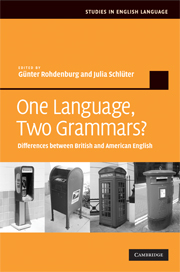Book contents
- Frontmatter
- Contents
- List of figures
- List of tables
- List of contributors
- Introduction
- 1 Colonial lag, colonial innovation or simply language change?
- 2 Compound verbs
- 3 The formation of the preterite and the past participle
- 4 Synthetic and analytic comparatives
- 5 Phonology and grammar
- 6 Prepositions and postpositions
- 7 Argument structure
- 8 Reflexive structures
- 9 Noun phrase modification
- 10 Nominal complements
- 11 Non-finite complements
- 12 The present perfect and the preterite
- 13 The revived subjunctive
- 14 The mandative subjunctive
- 15 The conditional subjunctive
- 16 Tag questions
- 17 The pragmatics of adverbs
- 18 How different are American and British English grammar? And how are they different?
- 19 New departures
- Bibliography
- Index
11 - Non-finite complements
Published online by Cambridge University Press: 03 July 2009
- Frontmatter
- Contents
- List of figures
- List of tables
- List of contributors
- Introduction
- 1 Colonial lag, colonial innovation or simply language change?
- 2 Compound verbs
- 3 The formation of the preterite and the past participle
- 4 Synthetic and analytic comparatives
- 5 Phonology and grammar
- 6 Prepositions and postpositions
- 7 Argument structure
- 8 Reflexive structures
- 9 Noun phrase modification
- 10 Nominal complements
- 11 Non-finite complements
- 12 The present perfect and the preterite
- 13 The revived subjunctive
- 14 The mandative subjunctive
- 15 The conditional subjunctive
- 16 Tag questions
- 17 The pragmatics of adverbs
- 18 How different are American and British English grammar? And how are they different?
- 19 New departures
- Bibliography
- Index
Summary
Introduction
The rivalry between infinitival and gerundial constructions is a widely recognized phenomenon in the grammatical system of the English language, probably because the gradual implementation of a verbal -ing form since late Middle English is unique among the European languages.
Large-scale analyses of historical as well as present-day electronic text corpora reveal that, in processes of linguistic change involving variable non-finite verb complementation, American English (AmE) has sometimes been lagging behind the parent variety while very often it is British English (BrE) that has been more conservative. The examples in (1) illustrate a case where AmE appears to be further advanced than BrE:
(1) a. We cannot stand seeing our own tactics displayed so obviously in another woman. (Guardian 1994)
b. … teachers digging into their own pockets because they cannot stand to see their students go without essential learning tools. (Los Angeles Times 1995)
Since Old English times, a series of linguistic processes has resulted in a reorganization of the entire system of sentential complementation. In Middle English, to-infinitives began to replace that-clauses after many verbs that had previously been confined to a finite clause (see Fischer 1997a: 268). In the area of non-finite complementation, gerunds increasingly took over the function of unmarked infinitives after certain verbs (see Fischer 1997a: 267, 1997b: 127, 2003: 454).
- Type
- Chapter
- Information
- One Language, Two Grammars?Differences between British and American English, pp. 212 - 227Publisher: Cambridge University PressPrint publication year: 2009
- 17
- Cited by

